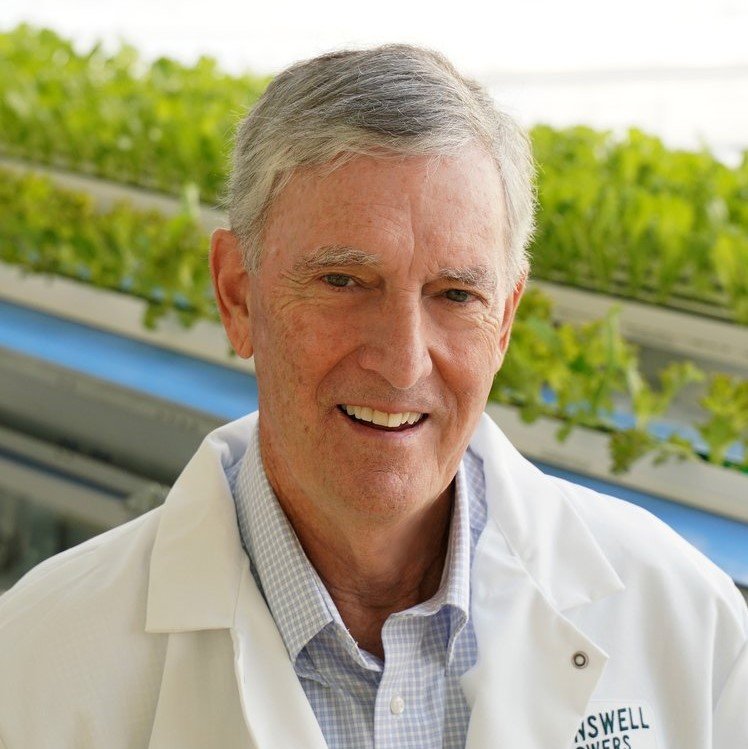Turning over a new leaf: Growing greens in a new way
Speakers (from left to right):
Charles “Chuck” Metzgar, a former managing director for the human resources consulting firm Mercer Inc., is chairman and co-founder of Greenswell Growers. He founded the business with Doug Pick, the president and CEO of Feed More, the hunger relief agency that operates Virginia’s largest food bank, and John May, a retired technology industry professional and president and CEO of the Center for Innovation and Development in Kilmarnock.
Carl Gupton has served as president of Greenswell Growers since November 2020. He worked in management positions focusing on the food industry for packaging companies Pohlig Packaging, 3C Packaging, and Commonwealth Packaging Corp.
A growing number of consumers want fresh products made and harvested locally.
But when it comes to leafy greens, about 95% of lettuce and similar products produced in the United States are grown in California and Arizona.
A Goochland County-based company wants to change that.
Greenswell Growers is growing leafy greens in a new way. The company is producing the greens at a large-scale indoor greenhouse.
The climate-controlled and highly automated hydroponic farming operation can produce about 750,000 pounds of leafy greens per year on the 1.5 acres. That’s compared with about 33,000 pounds to 35,000 pounds per 1.5-acre a year for a conventional growing operation in California or Arizona.
“This is the wave of the future,” Carl Gupton, president of Greenswell Growers, said during the Virtual Innovation Spotlight on Greenswell Growers’ operations.
The webinar, presented by RVA757 Connects, was held Tuesday Aug. 2.
“Ninety-five percent of what we consume comes out of Arizona or California. That's a big number,” Gupton said.
Yet one of the big problems with growing leafy greens on the West Coast, he said, is getting that product shipped across the country after it has been harvested.
Farming operations in California and Arizona face a declining availability of natural resources such as water, he said. Fewer farmers are available to meet the demands of a growing population while the U.S. consumption increases.
“Our greens are greenhouse grown,” he said. “That is the way we believe the world is evolving right now.”
At Greenswell Growers’ hydroponic operations, it takes about 21 to 28 days to grow leafy greens from seed to harvest, depending upon the type of product. A traditional farm takes about three or four months, he said.
The company also is able to control the environment inside the greenhouse and packaging operations, which enables its product to have an extended shelf life.
“Most of the product coming from California or Arizona that we all buy today has a shelf life in total of roughly five to seven days. The way we do our work here, the shelf life is minimally two weeks and up to 21 days,” said Charles “Chuck” Metzgar, a former managing director for the human resources consulting firm Mercer Inc. who is chairman and co-founder of Greenswell Growers.
The company’s product can be harvested one day and be on the store shelves or in restaurants later in the same day or the following day, Metzgar said.
The retail packaging has an extended shelf life because oxygen is removed from the container, Gupton said. A nitrogen flush system replaces the oxygen that would be in a tray or clamshell. That system also allows the company to use a fewer number of plastics.
The automation process also allows Greenswell Growers to grow its leafy greens with no human hands touching the product, he said.
Greenswell Growers produces two products – Essential Green Leaf (a good replacement for Iceberg lettuce) and Vibrant Greens Blend (like a spring mix). Coming in late August is a Romaine Blend.
The company supplies its fresh greens to grocery stores, restaurants, colleges and universities, senior living facilities, and food banks in Virginia. Soon, it plans to start selling its products in other states in the mid-Atlantic.
Food Lion stores in the Richmond region and Harris Teeter stores in Northern Virginia and Hampton Roads carry the greens. The company also supplies smaller stores in the Richmond area such as Libbie Market, Ellwood Thompson’s Local Market, and Good Foods Grocery. (See complete store locator here: https://greenswellgrowers.com/store-locator)
The leafy greens are now in the prepared salads that Henrico County-based Ukrop’s Homestyle Foods makes that are sold at Kroger stores in the Richmond area.
Restaurants in the Richmond area carrying Greenswell Growers’ products include Baker’s Crust, Dot’s Back Inn, Tazza Kitchen, Boathouse Restaurant Group, Lola’s Farmhouse Bistro and Buckhead’s.
In Hampton Roads, restaurants using the leafy greens include Bay Local, Ocean House Waterfront Seafood, York River Oyster Co., and Quemar.
Greenswell Growers also supplies local food banks – it is part of its Mission. The company provides 5% of its leafy greens to Feed More, the hunger relief agency that operates Virginia’s largest food bank, and also to Goochland Cares, the local food bank in Goochland County associated with FeedMore.
Metzgar got the idea for Greenswell Growers about eight years ago when Doug Pick, the president and CEO of Feed More, told him that the hunger relief agency was having problems getting fresh leafy greens to provide to those in need.
Metzgar and Pick were introduced to John May, a retired technology industry professional and president and CEO of the Center for Innovation and Development in Kilmarnock.
The trio started doing research when they met a very experienced family business that built hydroponic greenhouses across the U.S.
“We both saw a new future coming to growing produce in the USA,” Metzgar said, noting that the trio partnered with the family business.
Metzgar said the partnership has been a valuable and important arrangement.
“At the end of the day, this is all about what consumers are looking at in the produce they buy, which is a product that has a high-quality impression, solid green color, quality of the midrib, crisp leaves, and flavor,” Metzgar said.
“Therefore, ‘Plants First’ is our mission statement and is our ultimate goal and the main objective of our business. We have done everything we can to make this the best product available,” he said.




